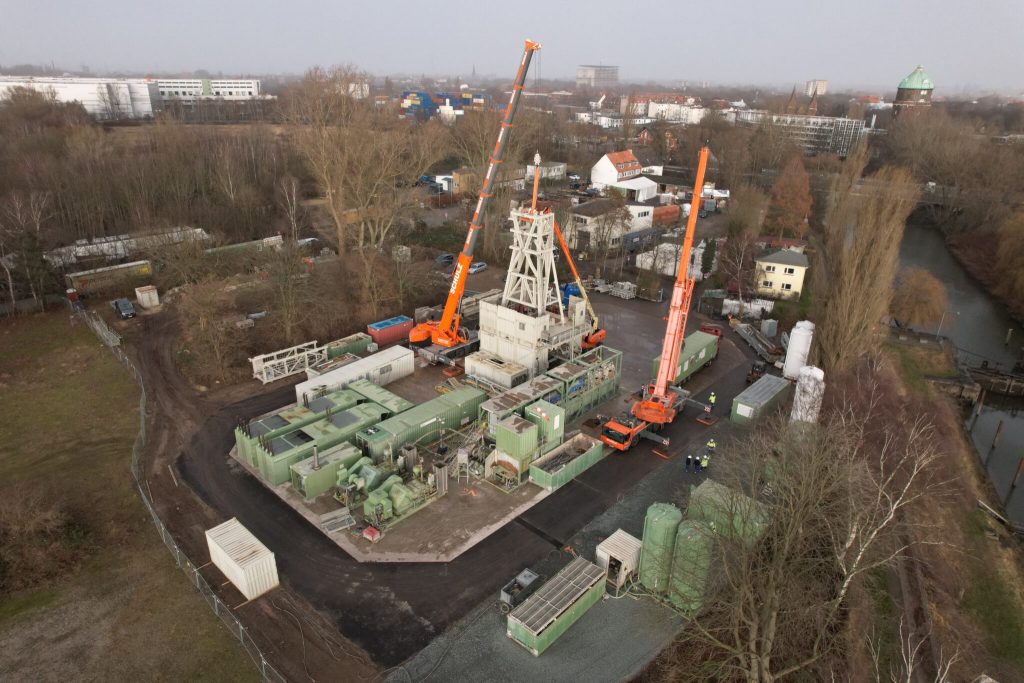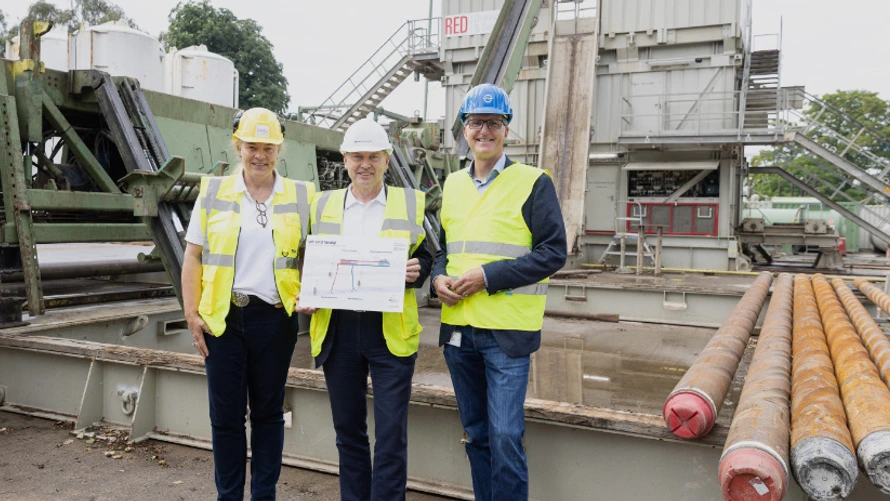Hamburg to push forward with drilling second geothermal well
The Hamburg geothermal project has announced plans for drilling a second well targeting a sandstone zone for a medium-temperature resource.
The geothermal project in Hamburg has announced it plans to drill a second well, following the results of the first exploration well drilled, as we reported.
At a depth of 1,300 meters, the project team from Hamburg Energie Geothermie GmbH, a joint subsidiary of Hamburger Energiewerke and HAMBURG WASSER, was able to detect thermal water in a rock layer about 130 meters thick. For this purpose, a well was drilled into this layer of rock. The first production tests have confirmed the permeability of the sandstone, so that the second well is now being drilled .
The second well will be drilled down into the reservoir to a depth of approximately 1,400 meters in a lateral diversion. Subsequent production tests should reliably quantify the geothermal potential in terms of production rate and temperature of the thermal water. This data is necessary to develop a possible geothermal heat generation for Hamburg-Wilhelmsburg. The water-bearing sandstone layer is around 45 million years old and was originally the beach area of ??the “young” North Sea.
Michael Pollmann, State Councilor for the Environment, Climate, Energy and Agriculture: “In addition to wind and sun, geothermal energy is another building block for a successful energy transition. In Wilhelmsburg, during the first geothermal well at medium depth, we came across an extremely promising source of thermal water, which gives reason to hope that we can use geothermal energy for the heat transition here and perhaps in other places as well. This now requires further evaluation of production rate and temperature, which we will do with drilling a second well. This second stage of the pilot project for the promotion of geothermal energy in Hamburg will provide us with further insights into the potential of this heat source in our metropolis. In this respect, we can hope that it will help us utilise this opportunity to become independent of fossil fuel energy sources.

Kirsten Fust, Managing Director of Hamburger Energiewerke GmbH: “With our exploratory drilling, we were able to successfully prove that thermal water flows in the Hamburg subsoil, which has the potential for geothermal heat generation. We have thus come a big step closer to our goal of generating base load, local eco-heat for Hamburg households. Now it’s time to drill the second well safely and wait for the results of the production tests.”
Ingo Hannemann, spokesman for the management of HAMBURG WASSER: “With the extensive geological know-how that we originally built up in the context of drinking water supply and that we bring to the project with our subsidiary CONSULAQUA, we have provided the basis for research into geothermal energy. Through the development of underground groundwater deposits, we know the subsoil well and know how it can also be used for climate-friendly energy solutions. The research accompanying the project has provided important insights that further complete the geological picture under Hamburg and contribute to making better use of its energetic potential.”
If the production test is successful, the thermal water will also be pumped later via the second well and returned to the reservoir in a closed circuit via the first deviated well (injection well). In general, at a depth of 1,300 meters, a thermal water temperature in a range of 45-50 degrees Celsius can be expected. However, the specific temperature must be determined for each location, which, together with other parameters such as the flow rate/ output, makes up the concept for renewable energy based heat production. The project team is currently working on various technical solutions that also take into account the use of heat pumps. The companies are optimistic that they will be able to present final results in the fall of this year.
The drilling was accompanied by an extensive scientific research program by mesoTherm in order to gain knowledge about the geothermal potential in the North German Basin. For this purpose, rock samples several meters long, so-called drill cores, were taken from different rock strata. These have also shown that sufficient thermal water deposits for geothermal use are not to be expected in sandstone layers at a depth of more than 3,000 meters. The sandstone layer at a depth of 1,300 meters has proven to be particularly thick at the Wilhelmsburg site. It was therefore examined for the first time for its geothermal potential using drill cores and hydraulic tests.
Inga Moeck, professor of geothermal energy at the Georg-August University of Göttingen and head of the geothermal energy department at the Leibniz Institute for Applied Geophysics, heads the accompanying scientific program mesoTherm: “Even in the 21st century, real discoveries are still possible. Through the drilling, we explored a newly discovered sandstone layer that was formed 45 million years ago and today shows very good properties for geothermal use. With the thermal water from this layer, we want to supply as many people as possible with renewable heat.”
The joint project mesoTherm is led by the Georg-August University of Göttingen, Geosciences Center, together with Geothermie Neubrandenburg GmbH (GTN) and the Leibniz Institute for Applied Geophysics (LIAG) as an associated partner and has the central goal of gaining knowledge about the geothermal reservoirs in northern Germany and their possible energetic use.
In addition to wind and sun, geothermal energy is the third pillar of renewable energy. It is constant and available locally. According to a study by the Federal Environment Agency, deep geothermal energy can contribute 118 TWh per year to climate-neutral heat supply by 2050. 42 deep geothermal systems are in operation in Germany with an installed heat output of almost 350 MW. Deep geothermal energy is understood here to mean systems with a drilling depth of more than 400 meters and an average depth of 2,500 meters.
The Hamburg geothermal project is part of the real laboratory IW3 – Integrated Heat Transition Wilhelmsburg, which aims to supply Wilhelmsburg residential areas with heat that is almost CO?-free. As a “real laboratory of the energy transition”, the Federal Ministry of Economics and Climate Protection (BMWK) is funding the project with a total of around 22.5 million euros to support research and development in the field of future-oriented energy technologies. In particular, the discovery risk in geothermal energy should be reduced through further knowledge.
Source: Hamburger Energiewerke


















